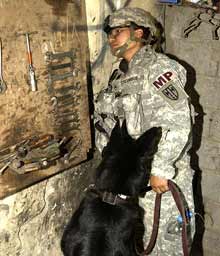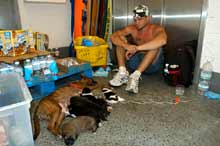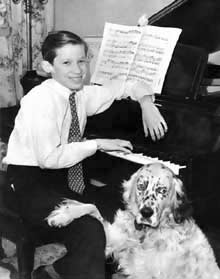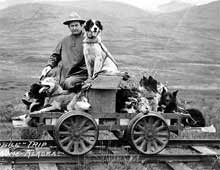|


August 18, 2008
Both came down from the trees in times of drying climate and the spread of open grasslands, though tens of millions of years apart. Both became long-legged, running, social hunters of large ungulates. Both proved versatile and hardy enough to survive another drastic climatic shift—from grass to ice. And at some point, they looked each other in the eye with recognition and respect—and chose to team up. It was a fateful moment (or millennium) for both Homo and Canis, that changed the course and sealed the dominance of both.
But when did it happen, and how? If one of the central impulses of lovers is to tell, over and over, the story of how they met, then when it comes to the dog we’re in the quandary of a lover with amnesia, impelled to tell a story we can’t remember. Maybe that’s why the origin of the canine-human bond is such a perennial subject of scientific speculation. If we can’t recall that first eye-lock some enchanted evening across a deserted ice floe, we will research and imagine it.
While fact checking our summer cover story, Wang & Tedford’s How Dogs Came to Run the World—which really tells the backstory of the evolutionary forces that brought dogs to the brink of that fateful encounter—I came across several fascinating pieces of speculation on how and when dogs and humans might have hooked up.
The “when” has only become more disputatious since scientists have begun digging into DNA as well as into the fossil record. My last post might have given you the impression that molecular geneticists, paleontologists, and archaeologists have mostly been exchanging high-fives as they reaffirm, if also refine, one another’s findings. That may be true for Homo, as these guys assert, but it’s quite another story with Canis. Recent investigations, using a “molecular clock” based on the known rate of divergence of wolf and coyote mitochondrial DNA, suggested that the ancestors of domestic dogs could have split from wild wolves as long as 100,000 or more years ago. Paleontologists and paleoanthropologists aren’t buying it.
That’s because there is, literally, no hard evidence—no canid bones that old either unambiguously associated with early humans or showing the structural changes that differentiate dogs from wolves: smaller body size, a wider cranium, a more prominent stop on the forehead, and a shorter jaw with crowded teeth. (These are characteristics of neoteny [do a find on the page for “neoteny,” but you may get hooked by the rest], the retention of juvenile features such as playfulness, dependency, and physical “cuteness,” often selected in the process of domestication.) Wolf bones have been found in “close association” with those of pre-Homo sapiens mammoth hunters close to half a million years ago, in China (Homo erectus pekinensis) and in Europe (Homo heidelbergensis, the likely ancestor of the Neanderthals), but some of the hominid bones show signs of gnawing by wolves, and there’s no evidence of any relationship more intimate than mutual theft of one another’s kills and, perhaps, mutual predation (wolves might have been killed for their fur). Meanwhile, a more promising partner for peace, H. sapiens, apparently evolves in Africa close to 200,000 years ago—where there are jackals but no wolves—and leaves the mother ship some 100,000 years later, drawing an oblivious step closer to the fateful rendezvous:
During the last Ice Age wolves were widespread throughout Europe and Asia, and modern humans had arrived in the Levant, Southern Europe, and Western Asia. In this period, 40,000–12,000 years before the present day, there is little or no evidence for cooperation between canids and humans, and essentially no archeological evidence for the presence of dogs . . . The end of the Ice Age marks the first archeological evidence for close coexistence of canids and humans.
And that evidence is explosive and unmistakable: almost as soon as there were recognizable dogs, we were burying them, like kin.
The article most cited on this subject, “Burying Key Evidence: The Social Bond Between Dogs and People” by Darcy F. Morey (Journal of Archaeological Science 33 [2006], 158–175), is the only one of those I want to show you that is, unfortunately, readable only for a hefty sum (unless you’re a subscriber to the Elsevier/ScienceDirect article service). So I’ll quote a bit of it, and right away you may notice a curious fact about this research topic: it makes scientists emotional.
Nothing signifies the social importance that people have attached to dogs more conspicuously than their deliberate interment upon death. . . . Such practices were indeed sometimes applied to other animals, but they did not take place with nearly the frequency that they took place with dogs. . . . [D]og burials are documented from every major land mass in the world except Antarctica. . . .

One conspicuous example is the Koster site, in the state of Illinois, where three domestic dog burials are not only the earliest known dog burials in North America, but were also among the oldest securely identified dogs in the world. They are about 8500 years old, and in terms of our knowledge about the standing of the dogs in human society, “Evidence from the Koster site hints that an affectionate relationship between humans and dogs may have existed more than 8,000 years ago in the North American Midwest.” [Morey is here quoting an earlier paper of his own.] . . .

[M]ore than 50 years ago, archaeologist William Webb encountered several examples of simultaneous dog and human interments at Indian Knoll in Kentucky, an Archaic site dating primarily from about 5500 to 4500 B.C. He initially noted the care with which dogs were often buried, by themselves or with people. He also provided photographs of such burials, and presented data showing that dogs were buried with both women and men, apparently in comparable frequencies. . . .

[I]t is clear that dogs served (and continue to serve) people by playing a variety of roles, many of them quite utilitarian. Moreover, such roles . . . undoubtedly served as an explicit rationale for maintaining the animals. What is less obvious is why these animals were so routinely accorded ritualistic burials upon death, much like an actual family member. Such treatment indicates a special bond between people and dogs that supersedes purely pragmatic considerations. Such a bond . . . calls for a convincing explanation. . . . I anticipate that task here by exploring the common perception by people of dogs as having spiritual qualities.
Of course, we have to beware of reading our own sentimental conceptions of animals (and for that matter, of “spiritual qualities”) into the unreadable minds of our hunter-gatherer ancestors. (Is there a word for the temporal equivalent of anthropomorphism? Anachronomorphism?) The dogs buried with people don’t seem to have been intended as a food supply for the final journey, but that doesn’t mean their kind weren’t also eaten, as Morey notes:
The lack of evidence for the animals being cut up or skinned before being buried is significant in light of the fact that dogs have frequently been used for food in certain regions, or their skins have been used for robes or clothing. In fact, at Indian Knoll in Kentucky . . . Webb felt that evidence supported the possibility that some dogs there were used for food. Morey and Aaris-Sørensen found and reported evidence that dogs had been used for food by some prehistoric occupants in arctic Greenland. A similar finding is true of many regions. In fact, dogs, or dog products, have been commonly put to use for a variety of utilitarian or decorative purposes.
Dogs evidently came across the Bering land bridge with the first humans to enter North America, at least 12,000 years ago (some 7 million years after their Caninae ancestors, which evolved in North America, went the other way, say Wang and Tedford). They may even have made the journey possible:
“Dogs are expensive traveling companions, who require food and care,” said [Robert K.] Wayne [of UCLA]. . . . “They must have served an important function in ancient societies, and have been thoroughly domesticated to move great distances without wandering off into the countryside. We believe they were a fundamental part of ancient societies. Dogs may have been valued for their hunting skills, security, transport, warmth [Three Dog Night!], perhaps even helping early travelers to move great distances.”
Almost certainly they also served as a food source on such moves. To understand why in a nearly contemporary context (1914-16), watch, if you can stand it, the NOVA program Shackleton’s Voyage of Endurance (currently available only in VHS). When explorer Ernest Shackleton’s crew understood that they were stranded in the Antarctic with limited food supplies, and could not hunt enough to feed their faithful but now useless sled dogs, they killed them—weeping—and stored their bodies for a food reserve. Any farm kid will tell you it’s an urban luxury to think that an animal cannot be both loved and eaten. It’s one of the ways we can’t imagine our ancestors’ lives.
So the dogs found in ancient human graves, even if they weren’t food, were certainly not pets as we understand them. They might have been servants, guardians, psychopomps—guides of the soul—or ritual sacrifices. Yet neither sacrificial nor utilitarian motives can explain why, about 6700 years ago in Tennessee, someone carefully
buried an old dog (a hunting companion?) so scarred and arthritic that he could never have lived that long without care. And this picture speaks to us so directly across ten millennia that our response can’t be all wrong:
 |
 |
|
This is a burial from the Natufian (PDF) hunter-gatherer culture of the Levant, right on the brink of the Neolithic, 10–12,000 years ago. Look closely and you will see that the hand of the deceased (an aged person of uncertain sex, probably a woman) rests on the skeleton of a small creature curled head to head with her in a posture that may give you a pang of recognition. It is a puppy, age perhaps four months. Now, the puppy was likely killed to accompany her into the afterlife—not our idea of humane love. But the intimate arrangement of the two is almost impossible to regard as only ritual and symbolic; its emotional and consoling quality is palpable.
There is an unbroken continuity from that photo to this to us. It’s before that photo that the gulf of amnesia yawns. Somehow, during that forgotten time, competing predators crossed over to become allies, coworkers, and even family members.
NEXT: So how did wolves become dogs? Who made the first move? Was it domestication or coevolution? And who changed whom more? In the absence of clear evidence, scientists use their imaginations—and their emotions.


(Annie Gottlieb) |
Comments (add yours!)

Return to July-August home
|








